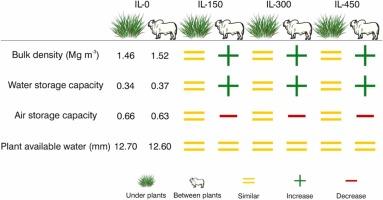氮肥可在不降低土壤物理质量的情况下加强放牧强度
IF 6.1
1区 农林科学
Q1 SOIL SCIENCE
引用次数: 0
摘要
通过施氮肥增加牧草生物量,可提高畜牧业生产系统的放牧率和放牧强度。然而,如果放牧率超过了土壤承载能力,放牧强度可能会损害土壤的物理质量。该研究的目的是量化在亚热带气候条件下长期(12 年)加强放牧 IPR-86 Milênio 栽培品种的最大秫米对沙质土壤(Luvisol Ferric 土壤)物理质量的影响。这项为期 12 年的田间试验采用完全随机的四分点设计。在不同的收获季节,动物进出围场的方式各不相同。在前五次收割中,使用和休息时间是固定的,每个围场占用 5 天,然后休息 35 天(即 40 天放牧周期)。在随后的收割中,根据牧草高度确定牲畜进出围场的时间,进入围场的牧草高度为 0.90 米,离开围场的牧草高度为 0.40 米。放牧强化水平(IL)包括不同的牲畜存栏率、放牧周期和牧草生物量,根据施氮剂量的不同而变化:施氮剂量分别为 0(IL-0)、150(IL-150)、300(IL-300)和 450(IL-450)公斤/公顷/年。在四个深度(0-0.10 米、0.10-0.20 米、0.20-0.30 米和 0.30-0.40 米)的两个取样位置(植株下和植株间)采集未扰动的土壤样本,用于测量几种土壤物理特性(如容重、大孔隙度、中孔隙度、小孔隙度、储水和储气能力、可利用水分、孔径分布和保水曲线)。放牧强度对土壤物理质量的影响较小,仅发生在植株之间和 0-0.10 米深处,在这些地方观察到土壤容重增加,微孔减少。加强放牧还提高了植株间的保水能力。无论取样位置和放牧强度如何,水和空气的储存能力都不会影响植物的生长。总之,由于氮肥施用量提高,牧草生物量增加,导致牲畜存栏量增加,但这并不会降低土壤的物理质量。本文章由计算机程序翻译,如有差异,请以英文原文为准。

Nitrogen fertilization allows grazing intensification without degrading soil physical quality
Increasing pasture biomass production through nitrogen fertilization enables greater stocking rate and grazing intensification in pastoral livestock production systems. However, grazing intensification can compromise the soil physical quality if stocking rates exceed the soil bearing capacity to support treading. The objective was to quantify the impact of long-term (12 years) intensified grazing of Panicum maximum Jacq. cv. IPR-86 Milênio on the physical quality of a sandy soil (Luvisol Ferric soil) under subtropical climate. The 12-year field experiment was arranged in a completely randomized split-plot design with four replicates. The approach for moving the animals in and out of the paddocks varied across harvests. In the first five harvests, the period of use and rest was fixed with each paddock being occupied for 5 days followed by 35 days of rest (i.e., 40-day grazing cycle). In the subsequent harvests, the timing for moving animals in and out of each paddock was based on pasture height, with entry set at 0.90 m and exit at 0.40 m. Grazing intensification levels (IL) consisted of different animal stocking rates, grazing cycles, and forage biomass, which varied depending on the nitrogen application doses: 0 (IL-0), 150 (IL-150), 300 (IL-300), and 450 (IL-450) kg of N ha−1 year−1. Undisturbed soil samples were taken at four depths (0–0.10, 0.10–0.20, 0.20–0.30, and 0.30–0.40 m) in two sampling positions (under plants vs. between plants) and used to measure several soil physical properties (e.g., bulk density, macroporosity, mesoporosity, microporosity, water and air storage capacity, available water, pore size distribution, and water retention curve). The impact of grazing intensification on soil physical quality was minor, occurring only between plants and at the 0–0.10 m depth, where an increase in soil bulk density and a decrease in microporosity was observed. Grazing intensification also increased the water retention capacity between plants. Regardless of the sampling position and the grazing IL, water and air storage capacity was not detrimental to plant development. Overall, the increased animal stocking rate resulting from the greater pasture biomass production due to improved nitrogen fertilization does not degrade soil physical quality.
求助全文
通过发布文献求助,成功后即可免费获取论文全文。
去求助
来源期刊

Soil & Tillage Research
农林科学-土壤科学
CiteScore
13.00
自引率
6.20%
发文量
266
审稿时长
5 months
期刊介绍:
Soil & Tillage Research examines the physical, chemical and biological changes in the soil caused by tillage and field traffic. Manuscripts will be considered on aspects of soil science, physics, technology, mechanization and applied engineering for a sustainable balance among productivity, environmental quality and profitability. The following are examples of suitable topics within the scope of the journal of Soil and Tillage Research:
The agricultural and biosystems engineering associated with tillage (including no-tillage, reduced-tillage and direct drilling), irrigation and drainage, crops and crop rotations, fertilization, rehabilitation of mine spoils and processes used to modify soils. Soil change effects on establishment and yield of crops, growth of plants and roots, structure and erosion of soil, cycling of carbon and nutrients, greenhouse gas emissions, leaching, runoff and other processes that affect environmental quality. Characterization or modeling of tillage and field traffic responses, soil, climate, or topographic effects, soil deformation processes, tillage tools, traction devices, energy requirements, economics, surface and subsurface water quality effects, tillage effects on weed, pest and disease control, and their interactions.
 求助内容:
求助内容: 应助结果提醒方式:
应助结果提醒方式:


